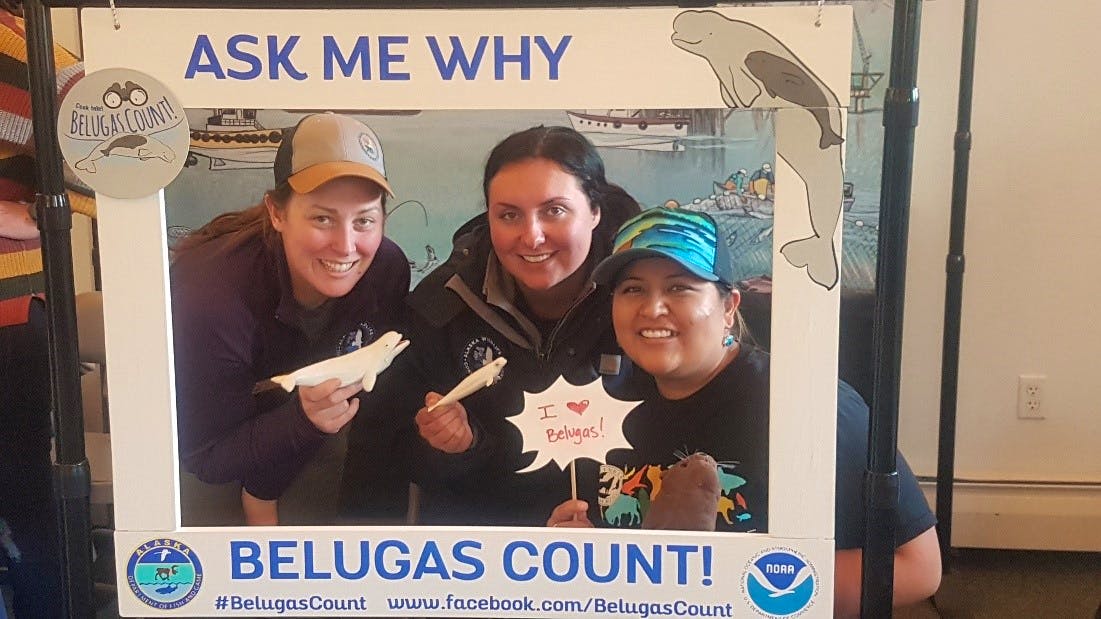Under gray skies, at the edge of Ship Creek, we were standing gazing out upon the silty, teal waters of Cook Inlet. The season’s first snow, termination dust signifying the end of summer, had recently fallen and lightly dusted the highest peaks surrounding Anchorage, Alaska. In the distance, the monochromatic clouds parted just enough to expose the golden sun glistening upon the snow-capped Alaska Range. Mount Susitna, our Sleeping Lady rested, perhaps dreaming about the same charismatic, melon-headed whales we are gathered to see. It was Belugas Count Day, an annual celebration of the critically endangered Cook Inlet beluga whales. We were patiently and eagerly waiting, monitoring, and hoping we would be so lucky as to view the critically endangered Cook Inlet beluga whales.
“When I first got here, there used to be belugas everywhere. You’d drive down the highway and just see white blobs everywhere,” recalled an elderly woman who brought her grandson to Belugas Count!. There was once a healthy population of nearly 1,300 belugas in Cook Inlet. Due to unregulated subsistence harvest, the population declined significantly and has yet to rebound, despite a moratorium on hunting. Today, the population estimate is just 328 and her chances of seeing a beluga have also declined drastically.
There were 15 sites along Cook Inlet, designated for observing the white whales. Defenders’ co-hosted site, Ship Creek, is centrally located in the middle of the Cook Inlet beluga’s designated critical habitat. It is also the most industrialized port in Anchorage. The ocean-scape seemed still, but the noise from active dredging, tugs towing barges, personal watercraft, and military, private, and commercial aircraft rang in our ears. We could only imagine what the noise must be like for the belugas, who rely on their specially adapted melon-shaped heads for echolocating and for all their essential behaviors when they come here to seek the spoils of the Creek. This multi-use site raises many questions about this intersection of wildlife, resources, and human use.
We were visited by 81 people throughout the day at Ship Creek, and between all the stations along Turnagain Arm about 2000 people took a moment to stop, to look, and to hope they could see the white whale.
One of the most popular places to see belugas is at Bird Point, where animals can often be spotted navigating around a rocky abutment that juts out into the inlet. A group there including one of our Defenders’ staff hiked out toward the point in a light rain late in the morning and were greeted by an Alaska Fish and Game volunteer offering coffee, snacks, binoculars and information about where belugas had been seen so far. They chatted for a while and dozens of people passed by, residents and tourists alike, coming and going and enjoying the scene.
They had their our own “nocs” (binoculars), and peering through some large spruce trees, quickly spotted one beluga slowly moving north. They continued walking out to the point, where there were a few spotting scopes set up for people to use. There, they saw more belugas milling around in a different location, close to some big rocks and not far from shore. They weren’t sure exactly how many were there, and they gained an appreciation for how difficult it must be to count significant congregations of animals. They spent another hour or so sharing the spotting scopes with others and chatting with volunteers about beluga conservation opportunities and challenges. As they were on their way out, more beluga enthusiasts streamed in, underscoring the curiosity and concern that many feel for these endangered wonders.
The festivities continued into the afternoon at the Alaska Zoo. The morning observation period was followed by expert talks and discussions about belugas from scientists and marine mammal curators from aquariums across the country. Upstairs, adults and kids alike could enjoy a hot chocolate with ‘beluga’ marshmallows while they engaged with representatives from Beluga Whale Alliance, Alaska Beluga Whale Monitoring Partnership, Shedd Aquarium, Alaska Fish and Game, Tyonek Native Corporation, Alaska Wildlife Alliance, National Oceanic Atmospheric Administration (NOAA), researchers, law enforcement, and of course, Defenders of Wildlife.
Part of the recovery plan for the Cook Inlet Belugas is to engage with the public. That’s why Belugas Count! exists, so that everyone can connect with these animals and give them a chance to thrive once again.
A total of 58 belugas were spotted at Kenai, Bird Point, Girdwood and Hope stations along the Seward Highway. Belugas Count! is an annual event, but community science (also known as citizen science) beluga whale monitoring happens seasonally through the Alaska Beluga Whale Monitoring Partnership. Monitoring the population is an important part of conservation of this species because, with so many unanswered questions as to why the population has not recovered, any information we can gather about where the belugas are and what they are doing is essential data. With so many dedicated people, professionals and community members alike, working to protect and recover this distinct population of belugas, we hope that in the future Belugas Count! will transform from a vision of recovery to a celebration of conservation success and abundance.
“Have you ever seen the belugas before?” we asked as a mother approaches with her 7-year-old son. “I have, but only once. My son never has.”














Follow Defenders of Wildlife
facebook bluesky twitter instagram youtube tiktok threads linkedin